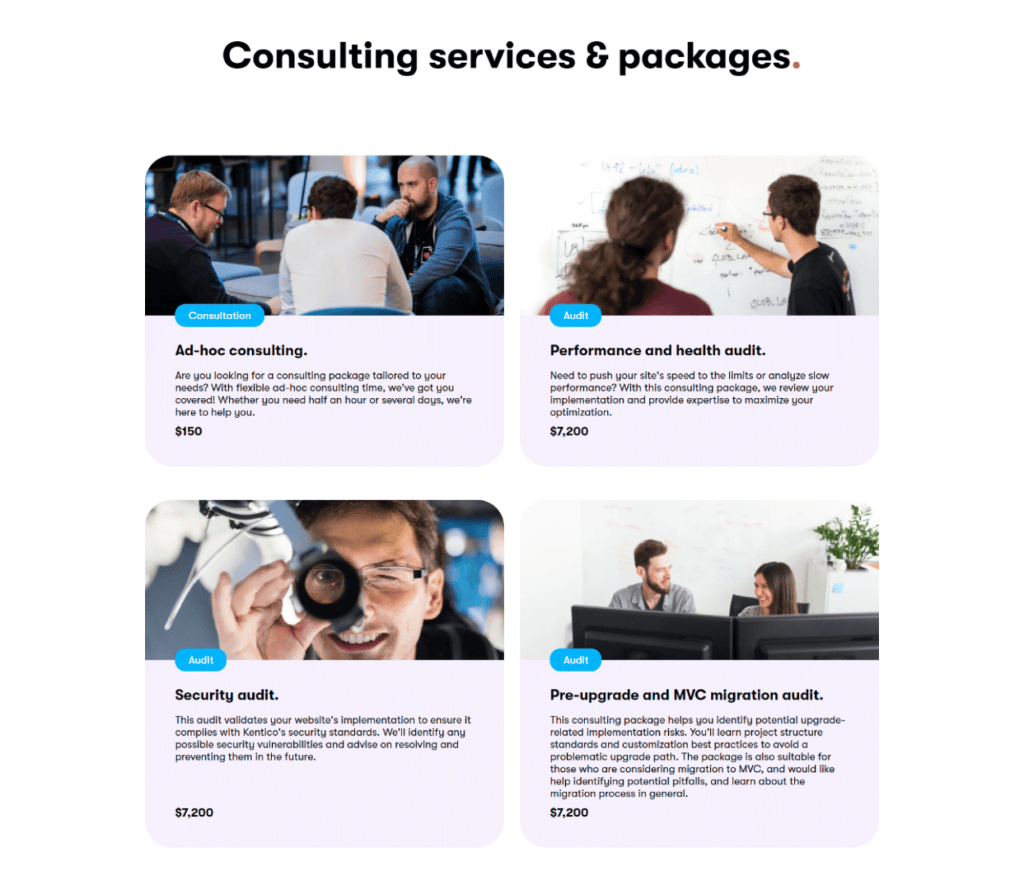The joys of sharing your hard-won knowledge on your own terms, whenever and however you want, with your own prices and flexible hours, may seem like a dream to many. It’s an especially attractive option for those who want to escape the typical 9-5 jobs, or who want to find new revenues as seniors.
It gets even more desirable once we see just how much can be earned. An hour with Chris Do, an Emmy award-winning designer and the founder of the Futur, costs $1499, while Devin Korwin’s one session on digital painting costs $1000. Impressive? Yes — but getting there is a hell of a ride.
After all, unless you’re a best-selling author or a renowned specialist that’s being invited to conferences left and right, it’s hard to convince people to pay you enough for such an intangible service. Especially with knowledge accessible more than ever — will a consultant teach me more than YouTube?
That’s why consulting isn’t such a piece of cake as it may seem at first glance. Consultants have to face many challenges, from convincing prospective clients to give them a shot to hunting down late payments. If you have a consulting practice of your own, we have some good news for you — there are ways to make your life easier, with the help of productized consulting services.
Brief Intro Into Productized Consulting
If you’re not sure what productized consulting is exactly, here’s a quick recap.
Productization is a business model which offers services in a fixed-scope and fixed-price format, similarly to an off-the-shelf product. This approach removes any ambiguity — the service is described in detail, costs are transparent, and nobody can argue about terms and conditions. If you’d like to see some real-life examples of productized services, check out this article.

Why should you care about this business model? It solves many problems that come with traditional consulting services and ensures more predictable and recurring revenue, efficient work practices, and growth opportunities. Note that you don’t have to go all in — you can stick to offering custom proposals while creating packages at the same time.
Let’s see which problems can be solved exactly by productizing your consulting services.
Problem #1: Writing Proposals
Each custom solution requires a unique, custom proposal that’s tailored specifically to each client. This means that these proposals can’t be reused.
Moreover, proposals are a vital part of negotiations. You can be sure that the proposal you’re sending is basically perfect, but clients, once given a free hand, can nitpick just about everything. This could lengthen the negotiation part more than necessary, along with straining your nerves and testing your patience.
On the other hand, some clients can be very vague in their expectations, settling for “we’ll deal with it when it comes for it”. Less experienced consultants can fall into this trap, which can result in future exploitation.
Once the proposal’s accepted, you can face another challenge: converting the proposal into a contract. After all, a proposal isn’t legally binding and therefore, isn’t necessarily looked at by legal specialists. Once they look through the contract itself, they can have even more objections. If your clients come from different industries or even countries, this can be more common than you might think.
SOLUTION
By productizing your consulting services you can say goodbye to all the unique needs and tailored terms — instead, you create one template that can be used for all the clients. After all, conditions were presented upfront, limiting the negotiation to bare basics, and the client knows beforehand what they’ve signed up for. There’s no room for misunderstandings, ambiguity, or complicated questions.
Problem #2: Scope Creep
Give somebody an inch and they’ll take a mile — that can be unfortunately true in the case of some of the more unpleasant clients. Unfortunately, we’re not always ready to afford to be picky. Taking on a few clients we wouldn’t otherwise consider is an ugly side of the business.
And even when the clients have only the best intentions towards us, we can overdo the pleasantries by bending over backward in order to delight and amaze them. We’ll throw in an extra treat, offer a discount, and grossly overdeliver. We’ll do everything we can to offer the best customer experience possible.
So once we’re already working with our customer and they ask for a little extra help or to handle one small additional task, we won’t say no. And then it will be two tasks, three, and five — all within the price set previously, leading us to the loss of money, time, and more resources.
Project scope creep can also happen due to wrong — or lack of — risk assessment. Turns out that the specific issue will take longer to handle or there are changes to the original plan. If it’s sudden, it’s easier to renegotiate the terms, but in case of a gradual stream of changes, asking for reassessment might feel awkward (especially when the client seems stressed enough already).
Nobody feels good about such a situation. But can you avoid it entirely?
SOLUTION
By introducing a clearly defined scope that includes additional pricing for any extra work or reiterations, you’re protecting yourself from exploitation and setting crisp boundaries in your business partnership. If your client wants to ask for more, you can simply point to the relevant fixed-price package without feeling awkward.
Problem #3: Long Sales Process
Ask any marketer — is acquiring new customers difficult? — and watch them burst into tears.
This is the hardest part of every trade and is particularly painful in the consulting business. Getting consumers to place their trust in those who want to get their money is a challenge, and rightfully so. According to the 2020 Edelman Trust Barometer, 53% of respondents consider trust as the most important factor when buying from a new brand, so we can expect even more mistrust towards individuals. That’s why showing off your recommendations, success stories, and positive feedback is a must.
But that’s only the beginning. Your potential customers will take their sweet time analyzing your landing page, comparing you to your competitors, and weighing all the pros and cons of hiring you. Vague information about your services and pricing will only increase their uncertainty. Answering as many questions as possible with your content and dispelling any doubts before the client even makes first contact is crucial. If you neglect that, new clients will take their sweet time making up their minds. Especially once they come face to face with a long-form and vague promise of getting back to them with pricing.
SOLUTION
Presenting a clear and detailed outline of your services along with pricing shortens the decision-making time by leaps and bounds. And the best way to do just that is by creating service packages that encapsulate all you can do for your client for a specific price. Your clients will surely appreciate such transparency.
Problem #4: Unpredictable Cash Flow
It’s impossible to expect steady revenue from a consulting business — after all, clients come and go as they please. It’s normal that some months, you’ll be busier than a one-armed paper hanger while during others, your office will start gathering dust. The so-called feast or famine trap of consulting is an ever-present challenge that many professionals keep struggling with. That’s why it’s important to prepare yourself for worse and better times for your consulting practice.
Unfortunately, it makes it difficult to plan around such an uncertain future, especially if you’re looking for both stability and growth. And work-life balance as well — after all, after weeks of no work, you’ll have a harder time refusing the less favorable deals and in result, work overtime.
SOLUTION
By offering a productized consulting service with a set price, you can more easily calculate the number of leads you need each month and create an evergreen customer acquisition strategy. This will help you stabilize your workflow and make it more predictable, allowing you to plan for the future more easily. From that point, you’ll be able to start creating a much more predictable process and optimize it as you go. In turn, your revenue stream will stop being so chaotic, allowing you to control your finances for once.
Problem #5: Billable Hours Are Problematic
Billing by the hours seems like the lesser evil, compared to the fixed price model. After all, the former is supposed to be more reliable than evaluating your general consulting services on the spot, without being sure of how the partnership will look like, exactly. In many cases, people tend to charge too low, so hourly billing seems like a more precise way of evaluating your expert guidance.
But there are downsides to this method as well. If you bill more hours than the client expected — and most clients undervalue intangible services — they might confront you about it and ask for clarification. You can find yourself in a spot where you have to explain each hour of your work, which is an uncomfortable place to be in.
And still, even before signing the contract with a client, you should be able to give a rough ballpark of hours the job will take you. And if you go way beyond the ballpark, you might disappoint or even anger your clients. The obvious solution would be to simply evaluate your work better — but if each job is unique, it’s a hard task to succeed at.
This leads to grinding — you’re under stress to deliver results as fast as possible in order to fit within the time limit. This approach might lead to mistakes and sloppy results, so it’s not really recommended.
SOLUTION
Since productized services are so specific and they come with a repeatable process, you’ll have an easier time estimating the resources needed to get the job done. Additionally, you’ll be able to optimize that process as you go or even automate it so that with each new client you spend less time on preparations.
Problem #6: Chasing Late Payments
In the case of billable hours, payment comes last. Unfortunately, many clients aren’t in a hurry to settle all those invoices or they get stuck under a pile on an accountant’s desk, so at times you might be forced to send courteous reminders that a payment is due. Then, you’ll have to wait for a response and then wait a bit more once it’s clear that the person responsible for payments is enjoying themselves on a nice holiday in Spain.
The more unpleasant clients might send you long essays on their business troubles and how they cannot pay you immediately, while others might start a feud over the number of hours billed. Some will ask — maybe there’s a discount if I hire you for another month?
Talking about money is always unpleasant and leaves a bad taste in one’s mouth, so maybe it’s something you should take care of first, before delivering your service.
SOLUTION
Usually, people pay for their products upfront, and it’s no different with productized services. If your service is presented as a product, people will part more willingly with their money upfront.
Problem #7: Difficult Management
If you’re still stuck in the billable hours payment model and you have a team under your control, it can get messy real fast. Not everyone is fastidious in keeping track of their hours — someone forgot to turn off the Clockify timer, another person keeps adding extra hours behind your back, or someone else keeps estimating their time badly — so your current data might not reflect reality. And if you’re basing your decisions on such data, you might make the wrong moves or not notice any warning signs.
If you want to judge your team members fairly, you’ll have to take into account many different factors in order to measure their performance. Going by simple numbers — like who finished their work the fastest — might lead to wrong conclusions. You’ll need lots of 1:1 meetings to truly know how things are going and to get to the bottom of any problems. Is someone slacking off, or are they making sure their work is exceptional? Are they truly that fast, or are they neglecting certain steps to get easy wins and impress you?
Additionally, any updates gathered during the job might be too vague or misleading. “Yeah, I’m working on it” someone might say and leave it at that, claiming they have everything under control. But do they?
SOLUTION
If you productize consulting services, it’ll be easier to hold your team accountable regarding their tasks and responsibilities. After all, you’ll already have a workflow set in place and the work divided into smaller chunks of manageable work, making updates easier to report and analyze the current situation.
Problem #8: Overworked
If you’re doing extremely well in your consulting business and there’s no ending stream of jobs for both you and your team to handle, maybe you should consider scaling. Of course, you can start hiring new employees — which is the obvious direction — but if lean months strike back, this decision might bite you in the ass. So instead, maybe you should work with what you have already and consider all your current processes.
If there are any manual, time-consuming tasks, it’d be good to automate them. If there are many files to be written, preparing ready-to-use templates could speed things up. If there are any tasks that nobody likes — for example, social media management — consider outsourcing them.
But it’s difficult to automate and streamline processes when each job is custom and therefore, completely different. So are you stuck in this custom hell for eternity and beyond?
SOLUTION
If you create different service packages, you facilitate your own work by finding the common tasks that have to be done in each case. Then, you can create processes that are partially automated, leading to better effectiveness of your entire team. For custom solutions, consider reaching out to a software business to develop an entire system of your own.
Productized Consulting Services: The Conclusion
Most consulting services offer their own productized service, be it in the form of additional support service or by completely remodeling their current business model and going all the way. This could only be a passing trend, or maybe they’re onto something — a way of working that’s more profitable and more beneficial to both the vendor and the clients, offering much more transparency and straightforward cooperation. By removing the ambiguity factor that follows such intangible services, you make it easier for people to understand the scope of your work and trust you.
If you still have some reservations, try at least partial productized consulting and take it for a test run. Even if you don’t settle for it in the end, you might gain a new perspective that could help you grow your service business.

A free online training. Delivered daily to your inbox to grow your productized agency.











